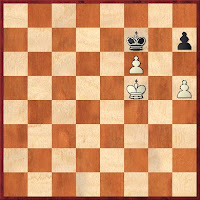1. Alekhine-Tartakower, Hamburg 1910 1-0
2. Czerniak-Villegas, Mar De Plata 1943 1-0

In his better days Benito Villegas was the Argentine chess champion. He lost this game by playing 58...Ke8?? Much better was 58...Kf8!
How do you choose a retreat square? Well, realize you want your king on e8 after White plays Ke6, h5, h6. In other words, you want your king on e8 in THREE tempos. So go to Kf8 for now. 58...Kf8! 59.Ke6 Ke8 60.h5 Kf8 61.h6 Ke8 62.f7+ Kf8 63.Kf6 draw. If this doesn't make sense, study K+P vs K. :)
3. Lengyel-Pogats, Budapest 1959 1-0
4. Nikolaevsky-Lenchiner, Dnipropetrovsk 1962 1-0
5. Clarke-Keller, Luzern, 1963 1-0
6. Jamroz-Szilagyi, Lublin 1968 1-0

Szilagyi played for Hungary in the 1956 Moscow Olympiad, but in this game he played 61...h6??, blundering away a draw. Much better was 61...Ke8! 62.Ke6 Kf8 63.h6 Kf8 64.f7+ Kf8 65.Kf6 draw.
As in the previous example, count your tempos when retreating, and never move your rook pawn unless you're forced to or you'll face the scenario I demonstrated to Takchess in my August 08, 2007 post--White wins by triangulating.
7. Ribli-Ree, Amsterdam 1973 1-0 (instructive for attacking)
8. Banas-Mista, Olomouc 1973 1/2-1/2 (instructive for defending)
9. Gaspar-Delaney, Tjentiste 1975 1/2-1/2

Gasper had a winning position, but he failed to nurture his reserve tempo when facing soon-to-be Irish champion Paul Delaney.
Here he played 47.f4? and an easy win become a difficult win. A couple turns later the draw became unavoidable. Better was 47.Kg5 Kg7 48.Kf5 Kf7 when White can use his reserve tempos to outflank Black and win in the usual way.
10. Azmaiparashvili-Eolian, Moscow 1979 1/2-1/2
11. Lein-Rosenlund, Copenhagen 1983 1/2-1/2
12. Forintos-Lukacs, Hungary 1986 1-0

Lukacs played 70...Ke8??. By now, you should be familiar with the theme of counting tempi before you retreat your king. 70...Kf8 would have drawn.
14. Lautier-Sorensen, Reykjavik 1988 1-0
15. Hector-Grassi, Genova 1989 1-0
16. Ristic-Pfrommer, Germany 1990 1-0
17. Epstein-Cejkova, Novi Sad 1990 1-0

We're definitely seeing a pattern. Cejkova forgot to count the number of tempi before retreating. Her 50...Kf8?? lost, while 50...Ke8! would have drawn.
18. Berestetsky-Hansen, Aalborg 1991 1/2-1/2

60.f7+?? What a colossal blunder. Anyone who's studies K+P vs K knows you should try to avoid advancing your pawn to the seventh rank with check. 60.h4! Kf8 61.h5 Ke8 62.h6 Kf8 63.f7 would have won easily since the Black king was on the wrong square.
19. Schneider-Spiegel, Ingelheim 1991 1-0

Schneider played 59.f5?. It's a natural move, but an error. You see, you can't win this position against best defense by promoting your bishop pawn. Instead, you must sacrifice it to outflank the enemy king and promote your rook pawn.
Winning is 59.Kd6! Kf6 60.h6! Kf5 61.Ke7! Kxf4 62.Kf6!. Whoever said pawn endings were easy? Schneider was lucky to later win this game when his opponent also blundered.
20. Dhong Thanh Nha-Bonin, New York 1991 1-0
21. Bencze-Vass, Hungary 1992 1-0

Bencze had an easy win until he advanced his h-pawn with 47.h4?? An attacker should never advance his rook pawn until the defender does likewise. The position was now drawn, but Vass resigned, apparently not realizing that.
22. Jicman-Ignatescu, Romania 1992 1/2-1/2
23. Konopka-Abraham, Berlin 1993 1-0

A common mistake--the defender didn't do a careful count before choosing a retreat square for his king. 71...Kf8? lost, but 71...Ke8 would have drawn. That's because the White king needed to be on Ke8 in four tempos.
24. Glodeanu-Zimmerman, Oderheiu 1993 1/2-1/2
25. Van Laatum-Golubev, Groningen 1993 1/2-1/2
I hope you've learned something from this. I certainly have! :)
Lessons Learned for this Endgame:
A. The defender should only move his rook pawn if forced to.
B. The attacker moves his rook pawn only after the defender does.
C. When retreating your king to the back rank, count carefully!
D. To win, you may need to sacrifice your bishop pawn and outflank.
E. If you're attacking and it's drawn, try a few tricky king moves.
F. Reserve tempos are as precious as diamonds.
G. Remember K+P vs K: don't push a pawn to the seventh rank with check.

2 comments:
I like the direction your blog is taking . I suggest if you have the energy to create a chessgames.com collection and link to that
Thanks, I'll check into that.
Post a Comment